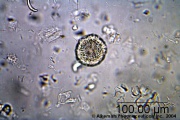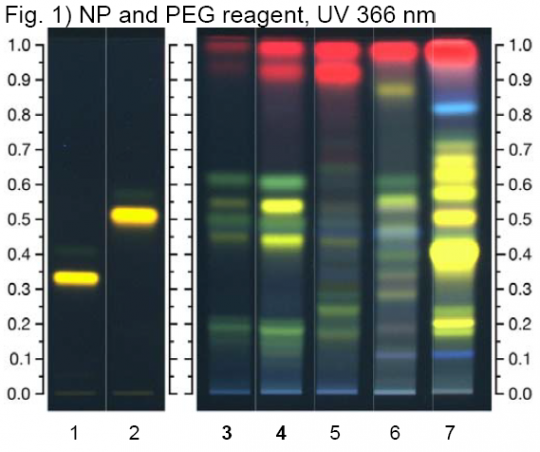Passiflora incarnata (aerial parts)
m (moved Passiflora incarnata (flower) to Passiflora incarnata (aerial parts): - →plant part correction) |
|||
| Line 2: | Line 2: | ||
=Macroscopic Entries= | =Macroscopic Entries= | ||
=Microscopic Entries= | =Microscopic Entries= | ||
| + | {{Microscopy | source=Elan M. Sudberg, Alkemist Laboratories | ||
| + | | companyimage= AP-LOGO-Laboratories Crop - Copy.jpg | ||
| + | | companyURL=http://www.Alkemist.com | ||
| + | | mainimage=Passiflora_incarnata-1_-_Alkemist_Laboratories.jpg | ||
| + | | caption1=Pollen grain measuring greater than 70 μm in diameter and showing a reticulated exine observed at 400x with Acidified Chloral Hydrate Glycerol Solution. | ||
| + | | description= Passion Flower (aerial parts) (''Passiflora incarnata'') | ||
| + | | image2=Passiflora_incarnata-2_-_Alkemist_Laboratories.jpg | ||
| + | | caption2=Large fragment of a fiber from the stem observed at 400x with Acidified Chloral Hydrate Glycerol Solution. | ||
| + | | image3=Passiflora_incarnata-3_-_Alkemist_Laboratories.jpg | ||
| + | | caption3=Clusters of calcium oxalate observed at 400x with Acidified Chloral Hydrate Glycerol Solution. | ||
| + | | image4=Passiflora_incarnata-4_-_Alkemist_Laboratories.jpg | ||
| + | | caption4=Beaded cell walls of the corolla observed at 400x with Acidified Chloral Hydrate Glycerol Solution. | ||
| + | | reference=British Pharmacopoeia, 2003 or European Pharmacopoeia 5.0 2005 | ||
| + | | }} | ||
| + | |||
| + | |||
=HPTLC Entries= | =HPTLC Entries= | ||
{{HPTLC | source=HPTLC Association | {{HPTLC | source=HPTLC Association | ||
Revision as of 00:57, 10 October 2012
Contents |
Introduction
Macroscopic Entries
Microscopic Entries
|
HPTLC Entries
|
Passion flower (aerial parts) (Passiflora incarnata) Lane Assignments Lanes, from left to right (Track, Volume, Sample):
Stationary Phase Stationary phase, i.e. Silica gel 60, F254 Mobile Phase Ethyl acetate, formic acid, water, ethyl methyl ketone 50:10:10:30 (v/v/v/v) Sample Preparation Method Sample: Mix 500 mg of powdered sample with 5 mL of methanol and sonicate for 10 minutes, then centrifuge or filter the solutions and use the supernatants / filtrates as test solutions. Derivatization reagents: 1) NP reagent Preparation: Dissolve 1g of natural products reagent in 200 mL of ethyl acetate. 2) PEG reagent Preparation: Dissolve 10 g of polyethylene glycol 400 in 200 mL of methylene chloride. Use: Heat plate for 3 min at 100°C, dip (time 0, speed 5) in NP reagent, dry and dip (time 0, speed 5) in PEG reagent. Detection Method Saturated chamber; developing distance 70 mm from lower edge; relative humidity 33% Reference see Reference: Individually dissolve 2 mg each of rutin and hyperoside in 5 mL of methanol. Other Notes Images presented in this entry are examples and are not intended to be used as a bases for setting specifications for quality control purposes. System suitability test: Rutin: orange zone at Rf ~ 0.32. Asiaticoside: orange zone at Rf ~ 0.50. Identification: Compare result with reference images. The fingerprint of the test solution is similar to that of the corresponding botanical reference sample. Additional weak zones may be present. The chromatogram of the test solution shows a greenish to yellow zone at Rf ~ 0.16. In the center of the chromatogram, above the position of reference substrate rutin there are four characteristic fluorescent zones: a yellow zone at Rf ~ 0.43, a green zone at Rf ~ 0.48, another yellow zone at Rf ~ 0.53 right above the position of the reference substance hyperoside, and another green zone at Rf ~ 0.60. Right below the solvent front there are red zones due to chlorophylls. Test for other species: No zone is seen between the green zone at Rf ~ 0.16 and the lowest zone of the group of four zones (yellow zone at Rf ~ 0.43) (Passiflora caerulea, Passiflora edulis, Passiflora biflora). No yellow zones are detected between the upper green zone at Rf ~ 0.60 and the red zones below the solvent front (Passiflora biflora).
|
Other Points of Interest
Cite error: <ref> tags exist, but no <references/> tag was found


